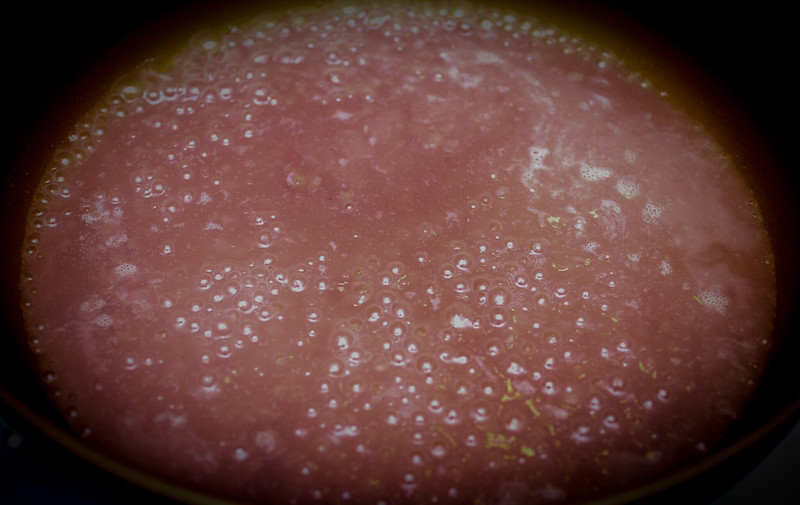
In Hawai’i, poi is a native cuisine of Hawai’i and is made from taro (kalo), a rooted vegetable and is considered one of the the earliest cultivated plants.
Traditionally poi is produced by mashing the cooked corm (taro root) which is steamed or baked on a papa ku’i ‘ai, a wooden pounding board with a a basalt pestle (pohaku ku’i ‘ai). It can be stored indefinitely without any fear of spoilage. It’s also a hypoallergenic food, it’s a superfood and is also probiotic.
Poi is no doubt significant in Hawaiian culture and it’s believed that poi sustained the first people who landed on Hawaiian shores.
One thing that I recommend is for those to watch this video from Daniel Anthony about “Hawaiian poi”, you’ll learn a lot from this video alone (and also other videos featuring Daniel):
Poi has an interesting history as it became a school meal since the late 1880’s and served with every meal but the state suffered a taro shortage when sugar barons used taro fields for sugar cane.
But as sugar cane fields disappear, many land used for farming is now being purchased by developers for housing.
Of course, for those in the mainland, depending on where you live, kalo is not as easily available.
But that shouldn’t deter you from not eating poi wherever you may live outside of Hawaii. Because you can purchase powdered poi from Taro Brand and HPC Foods (HPC is for Honolulu Poi Co.).
The company was oriignally founded by Kakuichi Tottori back in 1946 and its the state’s largest poi manufacturer, producing more than 40,000 pounds a week (2 million pounds a eyar).
Tottori was one of the first farmers in Hawai’i to ship fresh pineapple to the mainland and after World War II, he entered the poi business and since then has been passed down to generation to generation as Kakuichi’s son James Ichiro took over, then Kakuichi’s son, Ernest and the business is expected to be passed to the fourth generation of the Tottori family.
Ernest Tottori who is a welder and machinist by trade, had built a special machine which had a specially designed pressure cooker to prepare more than six tons of taro per hour and the company operates at a distribution facility in Kalihi which produces and packages poi.
The company is a big supporter of local farmers and this has always been the goal of Kakuichi when the company was founded and that was to develop a more local industry and his father’s concept was to preserve farmers in Hawai’i.
Poi is high in calcium and iron, no dairy and has no wheat. With powdered poi, all you have to do is mix with water. In fact, there are parents in Hawai’i who introduce poi to their infant as their first food.
While I wish I could make my own poi, taro is not something I can grow in this California hot and dry climate, so I go with the powdered poi ordered from Hawai’i.
Now how to make poi from powder?
I purchase a bagged version as it does come with more.
You can use stove top (my preference) or microwave. But you need hot water.



I prefer my poi more towards a thicker than runnier side but it all depends on you.
I tend to fill up a coffee cup filled with water and then pour into a sauce pan. I then put pour poi and you can see immediately if it will be runny or thick, I don’t use a measuring cup for this, I go by sight and how things look when I stir it for minutes. I keep stirring until I see a lot of bubbles and know it’s super hot.
But for those who want to measure, one ounce of powder needs about two tablespoons of water. If you purchase the 3 oz. bottled poi powder from Taro Brands, one 3 oz of powder needs 12 ounces (1 1/2 cups) of water. Personally, I think it’s easier to look and see if it’s what you like especially from stirring it.
The photos above, shows it as thick, the photo below it is not so thick and not so runny (in between), while the final photo shows poi runny. It all depends on how much water you put and what is your preference. Thicker or soupy.
Oh, and one more thing… Please don’t use your finger to taste the poi from the hot pan, you’ll burn your finger. Use the spatula or get a spoon to taste.
Poi has a slightly sweet taste that slowly goes sour. Some people like it sour, I like it just off the pan and made sweeter, so I do add sugar to my poi to sweeten it a bit. But for those want their poi to be sour, after cooking, put it in the fridge and wait three days.
If anything, don’t make it pu’upu’u (lumpy). So stir well in the pan to break up the powder and make sure it makes no clumps. (Note: Serving lumpy poi is disgraceful in Hawaiian culture, so make sure you don’t eat it lumpy).
In Hawai’i, people use one finger poi if it’s a thicker poi and two fingers if it’s a bit runny. Three fingers…that’s way too runny (no good). But for sanitary folks who can’t eat with their finger, if course, there is no shame if you use a spoon.
It’s also an alternative to rice and in Hawai’i, many people like to eat poi with fish.
Again, this is not going to beat eating truly fresh poi. But if you are not in Hawai’i and no access to get Taro Brand fresh poi in your area, get the powdered Taro Brand Hawaiian Poi Powder.
